Abstract
One hundred forty-two strains of Escherichia coli isolated from extraintestinal infections were examined for colicin V (ColV) and hemolysin (Hly) production. For comparison, 20 strains isolated from the feces of normal individuals and 12 enteropathogenic strains of E. coli were tested for these properties. Thirty-five to 59% of extraintestinal isolates were Hly+, but only one fecal strain was Hly+. Colicin V biosynthesis was found for 12% of blood culture isolates, 7% of urine culture isolates and 16% of the strains from other extraintestinal infections. None of the fecal isolates was ColV+. Selected strains were tested for virulence in 13-day-old chicken embryos; these same strains were tested for their ability to hemagglutinate chicken or human erythrocytes. Of 22 extraintestinal isolates, 13 (59%) killed greater than or equal to 60% of the embryos within 72 h. Only one of eight normal fecal isolates and two of three enteropathogenic strains tested were virulent. About 80% of the virulent strains were Hly+. The most striking finding, however, was the hemagglutination of human erythrocytes by virulent extraintestinal isolates. It seems possible that the hemagglutination property reflects a specific common adherence factor.
Full text
PDF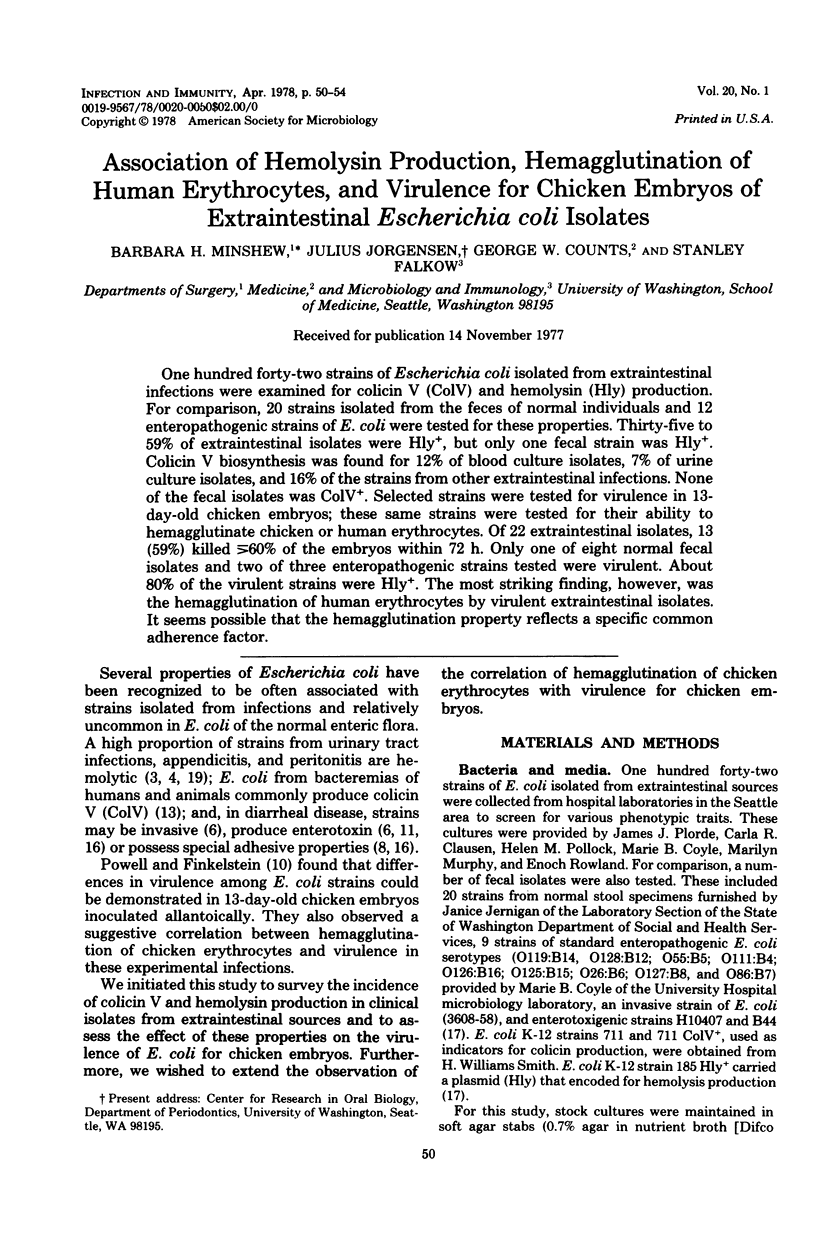
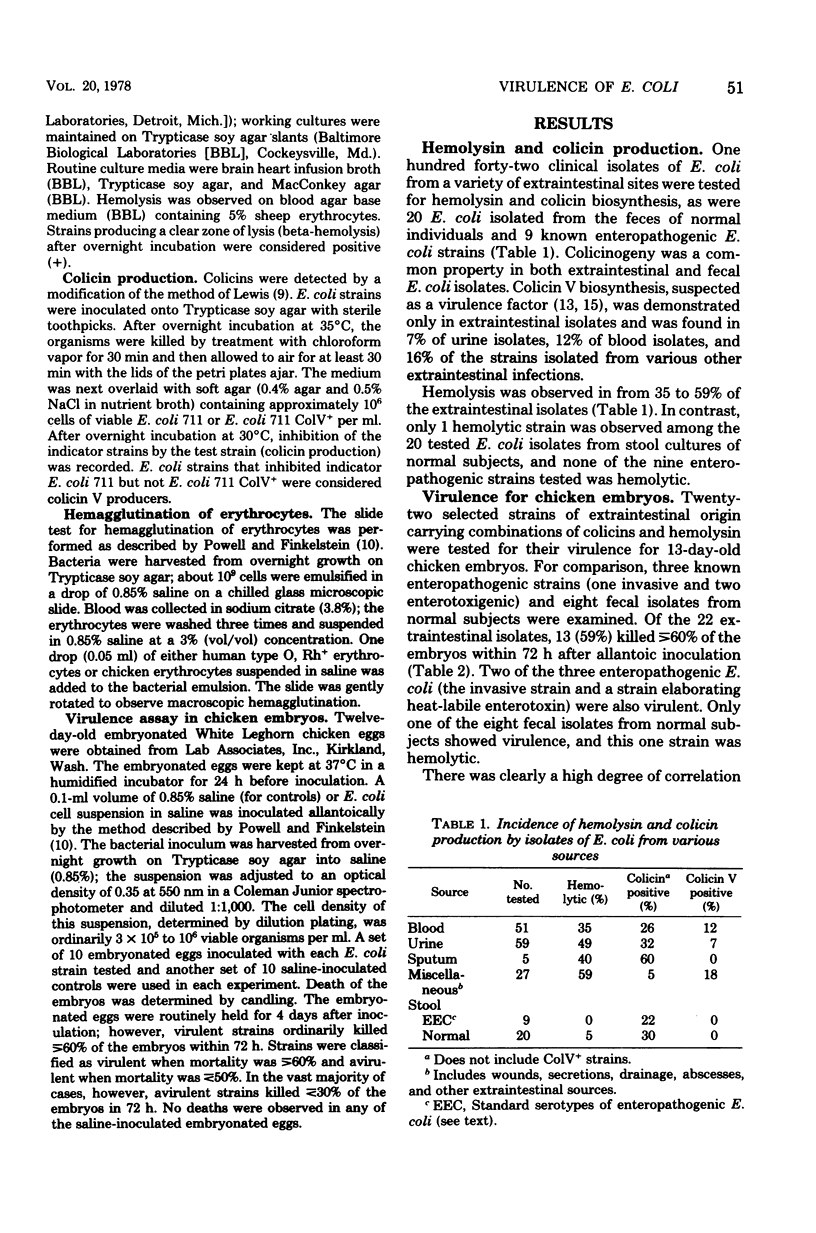
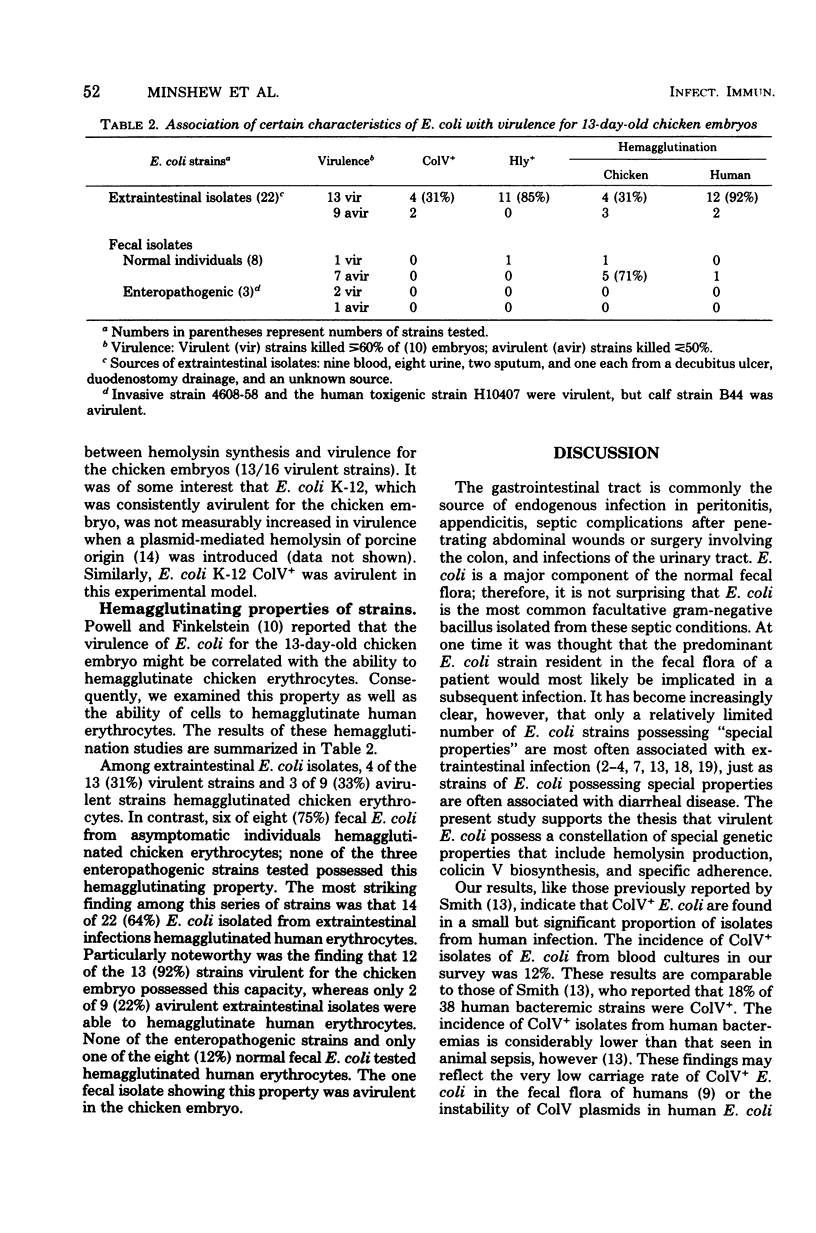
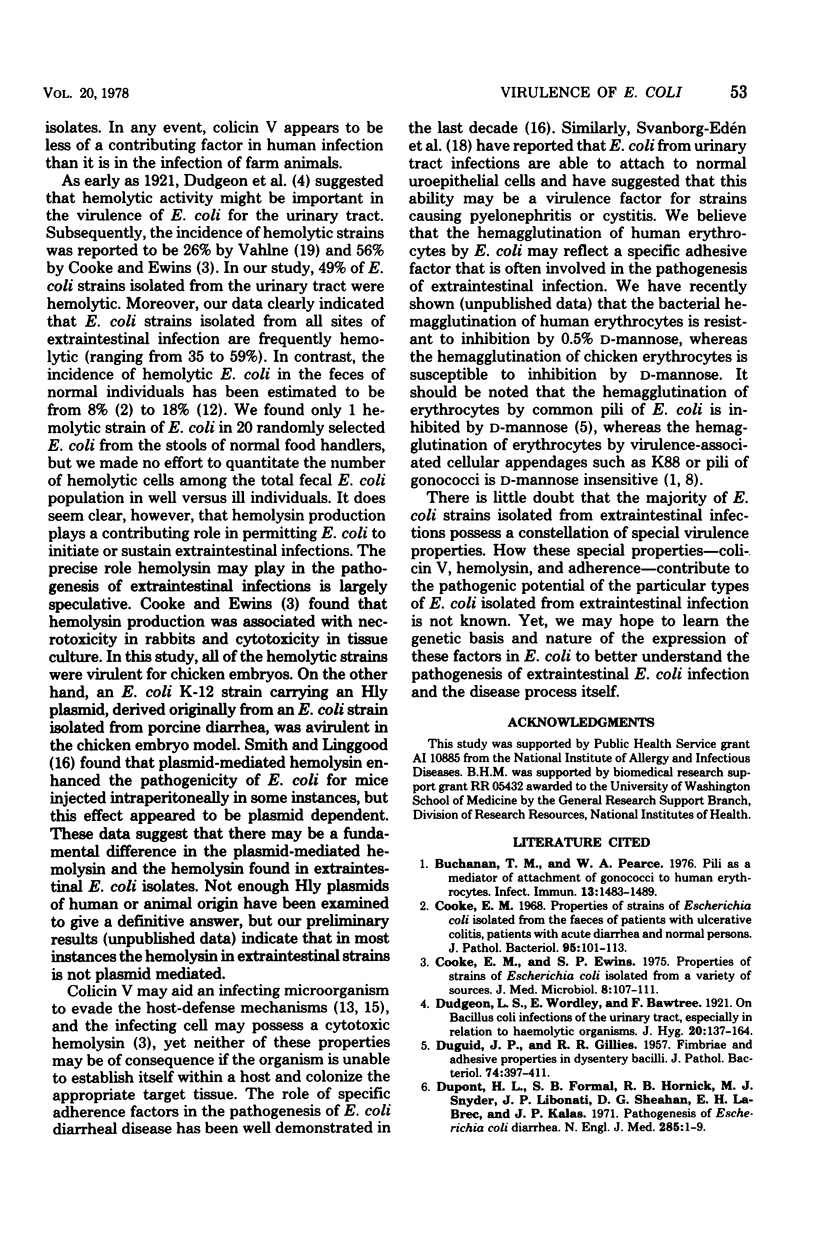
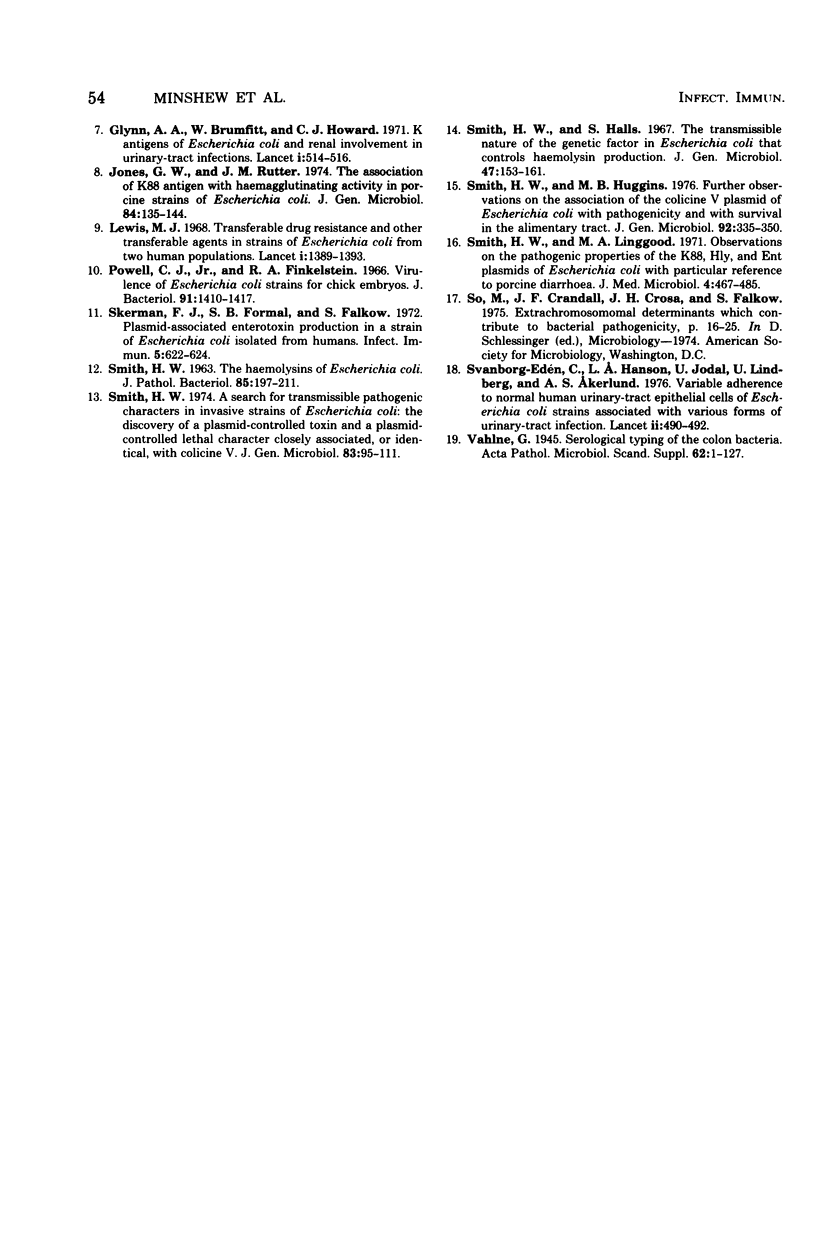
Selected References
These references are in PubMed. This may not be the complete list of references from this article.
- Buchanan T. M., Pearce W. A. Pili as a mediator of the attachment of gonococci to human erythrocytes. Infect Immun. 1976 May;13(5):1483–1489. doi: 10.1128/iai.13.5.1483-1489.1976. [DOI] [PMC free article] [PubMed] [Google Scholar]
- Cooke E. M., Ewins S. P. Properties of strains of Escherichia coli isolated from a variety of sources. J Med Microbiol. 1975 Feb;8(1):107–111. doi: 10.1099/00222615-8-1-107. [DOI] [PubMed] [Google Scholar]
- Cooke E. M. Properties of strains of Escherichia coli isolated from the faeces of patients with ulcerative colitis, patients with acute diarrhoea and normal persons. J Pathol Bacteriol. 1968 Jan;95(1):101–113. doi: 10.1002/path.1700950112. [DOI] [PubMed] [Google Scholar]
- Edén C. S., Hanson L. A., Jodal U., Lindberg U., Akerlund A. S. Variable adherence to normal human urinary-tract epithelial cells of Escherichia coli strains associated with various forms of urinary-tract infection. Lancet. 1976 Sep 4;1(7984):490–492. [PubMed] [Google Scholar]
- Glynn A. A., Brumfitt W., Howard C. J. K antigens of Escherichia coli and renal involvement in urinary-tract infections. Lancet. 1971 Mar 13;1(7698):514–516. [PubMed] [Google Scholar]
- Jones G. W., Rutter J. M. The association of K88 antigen with haemagglutinating activity in porcine strains of Escherichia coli. J Gen Microbiol. 1974 Sep;84(1):135–144. doi: 10.1099/00221287-84-1-135. [DOI] [PubMed] [Google Scholar]
- Lewis M. J. Transferable drug resistance and other transferable agents in strains of Escherichia coli from two human populations. Lancet. 1968 Jun 29;1(7557):1389–1393. doi: 10.1016/s0140-6736(68)91973-9. [DOI] [PubMed] [Google Scholar]
- Powell C. J., Jr, Finkelstein R. A. Virulence of Escherichia coli strains for chick embryos. J Bacteriol. 1966 Apr;91(4):1410–1417. doi: 10.1128/jb.91.4.1410-1417.1966. [DOI] [PMC free article] [PubMed] [Google Scholar]
- SMITH H. W. The haemolysins of Escherichia coli. J Pathol Bacteriol. 1963 Jan;85:197–211. doi: 10.1002/path.1700850119. [DOI] [PubMed] [Google Scholar]
- Skerman F. J., Formal S. B., Falkow S. Plasmid-associated enterotoxin production in a strain of Escherichia coli isolated from humans. Infect Immun. 1972 Apr;5(4):622–624. doi: 10.1128/iai.5.4.622-624.1972. [DOI] [PMC free article] [PubMed] [Google Scholar]
- Smith H. W. A search for transmissible pathogenic characters in invasive strains of Escherichia coli: the discovery of a plasmid-controlled toxin and a plasmid-controlled lethal character closely associated, or identical, with colicine V. J Gen Microbiol. 1974 Jul;83(0):95–111. doi: 10.1099/00221287-83-1-95. [DOI] [PubMed] [Google Scholar]
- Smith H. W., Halls S. The transmissible nature of the genetic factor in Escherichia coli that controls haemolysin production. J Gen Microbiol. 1967 Apr;47(1):153–161. doi: 10.1099/00221287-47-1-153. [DOI] [PubMed] [Google Scholar]
- Smith H. W., Huggins M. B. Further observations on the association of the colicine V plasmid of Escherichia coli with pathogenicity and with survival in the alimentary tract. J Gen Microbiol. 1976 Feb;92(2):335–350. doi: 10.1099/00221287-92-2-335. [DOI] [PubMed] [Google Scholar]
- Smith H. W., Linggood M. A. Observations on the pathogenic properties of the K88, Hly and Ent plasmids of Escherichia coli with particular reference to porcine diarrhoea. J Med Microbiol. 1971 Nov;4(4):467–485. doi: 10.1099/00222615-4-4-467. [DOI] [PubMed] [Google Scholar]


